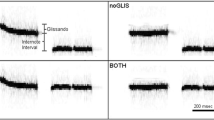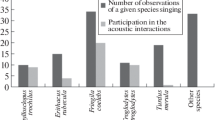Summary
-
1.
Split songs — stimulus arrangements in which parts of cricket calling songs are delivered from different directions via two loudspeakers — have been used to place constraints on the recognition and direction-determining processes in the field cricketGryllus bimaculatus, walking on the Kramer spherical treadmill. Parts of a calling song, each ineffective when delivered alone, can combine to elicit recognition and tracking when interleaved from two speakers 135° apart in azimuth.
-
2.
If two correct songs (40-ms syllable repetition interval) are delivered from the two speakers, but time-shifted by a half interval so that their composite (20-ms intervals) is incorrect, then the angle bisecting the speaker separation (where the two should appear equally loud) might be expected to be an ‘unfavored zone’; the animals do in fact tend to avoid that region. As in controls on ‘choice’ experiments with interleaving of complete chirps, if one speaker is increased in sound intensity it tends to be favored.
-
3.
If two incorrect songs (80-ms syllable repetition interval) are delivered from the two speakers, again time-shifted by half a syllable interval so that the composite is correct (40-ms intervals), then angles near those bisecting the speaker separation might be expected to be favored, and most animals track in that way. Surprisingly, however, when one speaker is increased in sound intensity in this case most animals show a marked shift of tracking toward the less-loud speaker at test intensities near 60 and 70 dB. At 80 dB the effect is reversed.
-
4.
About one-third of females track trill — continuous trains of syllables at the correct syllable rate but with no subdivision into chirps; these were tested with split trills. If alternate syllables of the trill were delivered from the two speakers, or alternating doublets, tracking tended to bisect the 135° angle between speakers. With alternating triplets or higher n-tuples, one or the other speaker was tracked quite accurately. This ability to lock on to one signal despite the presence of another (at 135°) was tested at smaller speaker separations (90°, 65°, 45°); the animals then usually fail to select one speaker.
-
5.
The above results are difficult to explain via a putative ‘tracking comparator’ with ‘cardioid’ inputs from the two sides of the auditory system. In particular, the distinct behaviors with respect to intensity imbalance (2 and 3 above, for different ranges of syllable repetition interval of split songs) suggest that bilateral dynamic interactions in the CNS may be involved. Specific correlates of these effects can be sought in multiple-source or dual leg-phone experiments with electrophysiological monitoring of prothoracic and brain cells.
Similar content being viewed by others
References
Bailey WJ, Thomson P (1977) Acoustic orientation in the cricketTeleogryllus oceanicus (Le Guillou). J Exp Biol 67:61–75
Boyan GS (1979) Directional responses to sound in the central nervous system of the cricketTeleogryllus commodus (Orthoptera: Gryllidae). 1. Ascending interneurons. J Comp Physiol 130:137–150
Boyd P, Lewis B (1983) Peripheral auditory directionality in the cricket (Gryllus campestris L,Teleogryllus oceanicus Le Guillou). J Comp Physiol 153:523–532
Doherty JA (1985a) Trade-off phenomena in calling song recognition and phonotaxis in the cricket,Gryllus bimaculatus (Orthoptera, Gryllidae). J Comp Physiol A 156:787–801
Doherty JA (1985b) Phonotaxis in the cricket,Gryllus bimaculatus (De Geer): comparisons of choice and no-choice paradigms. J Comp Physiol A 157:279–289
Geldard FA, Sherrick CE (1986) Space, time and touch. Sci Am 255:84–89
Heiversen D von (1984) Parallel processing in auditory pattern recognition and directional analysis by the grasshopperChorthippus biguttulus L. (Acrididae). J Comp Physiol A 154:837–846
Hill KG (1974) Acoustic communication in the Australian field cricketTeleogryllus commodus andT. oceanicus (Orthoptera, Gryllidae). Thesis, University of Melbourne
Huber F, Thorson J (1985) Cricket auditory communication. Sci Am 253:60–68
Huber F, Kleindienst HU, Weber T, Thorson J (1984) Auditory behavior of the cricket. III. Tracking of male calling song by surgically and developmentally one-eared females, and the curious role of the anterior tympanum. J Comp Physiol A 155:725–738
Murphey RK, Zaretsky MD (1972) Orientation to calling song by female crickets,Scapsipedus marginatus (Gryllidae). J Exp Biol 56:335–352
Nolen TG, Hoy RR (1984) Initiation of behavior by single neurons: the role of behavioral context. Science 226:992–994
Oldfield BP (1980) Accuracy of orientation in female crickets,Teleogryllus oceanicus (Gryllidae): dependence on song spectrum. J Comp Physiol 141:93–99
Pollack GS, Plourde N (1982) Directionality of acoustic orientation in flying crickets. J Comp Physiol 146:207–215
Rheinlaender J, Blätgen G (1982) The precision of auditory lateralization in the cricket,Gryllus bimaculatus. Physiol Entomol 7:209–218
Schildberger K (1984) Temporal selectivity of identified auditory neurons in the cricket brain. J Comp Physiol A 155:171–185
Schmilz B (1983) Analyse der akustischen Orientierung bei Grillenweibchen (Gryllus campestris L.). Dissertation, Köln, FRG
Schmitz B (1985) Phonotaxis inGryllus campestris L. (Orthoptera, Gryllidae). III. Intensity dependence of the behavioural performance and relative importance of the tympana and spiracles in the directional hearing. J Comp Physiol A 156:165–180
Schöne H (1980) Orientierung im Raum. Wissenschaftliche Verlagsgesellschaft, Stuttgart, p 257, Fig. 3.6/20
Thorson J, Weber T, Huber F (1982) Auditory behavior of the cricket. II. Simplicity of calling-song recognition inGryllus, and anomalous phonotaxis at abnormal carrier frequencies. J Comp Physiol 146:361–378
Weber T (1984) Acoustical recognition in crickets. In: Varjú D, Schnitzler HU (eds) Localization and orientation in biology and engineering. Springer, Berlin Heidelberg New York, pp 181–185
Weber T, Thorson J, Huber F (1981) Auditory behavior of the cricket. I. Dynamics of compensated walking and discrimination paradigms on the Kramer treadmill. J Comp Physiol 141:215–232
Wiese K, Eilts K (1985) Evidence for matched frequency dependence of bilateral inhibition in the auditory pathway ofGryllus bimaculatus. Zool Jb Physiol 89:181–201
Zaretsky MD (1972) Specificity of the calling song and short term changes in the phonotactic response by female crickets,Scapsipedus marginatus (Gryllidae). J Comp Physiol 79:153–172
Zhantiev RD, Kalinkina IN, Chukanov VS (1975) The characteristics of the directional sensitivity of tympanal organs inGryllus bimaculatus De Geer (Orthoptera, Gryllidae). Entomol Obozr 54:249–256
Author information
Authors and Affiliations
Rights and permissions
About this article
Cite this article
Weber, T., Thorson, J. Auditory behavior of the cricket. J. Comp. Physiol. 163, 13–22 (1988). https://doi.org/10.1007/BF00611992
Accepted:
Issue Date:
DOI: https://doi.org/10.1007/BF00611992




